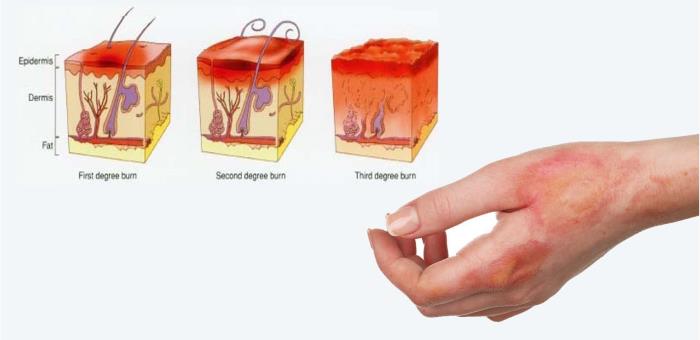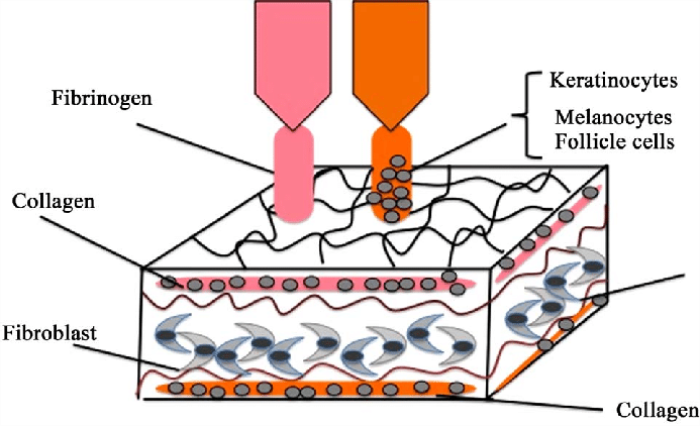Burn treatment has evolved significantly over time, from traditional methods like wound dressings and antiseptic applications to modern advanced techniques such as skin grafting and regenerative therapies. Traditional approaches primarily focused on cleaning the wound, applying dressings, and preventing infection. This method was effective for minor burns but often led to complications in severe cases.
Modern treatments have introduced more sophisticated methods like skin grafts, artificial skin substitutes, and therapies to promote tissue regeneration. Advances in burn care now emphasize not only healing the wound but also reducing scarring, restoring functionality, and improving the patient’s quality of life through innovative solutions like stem cell therapy and bioprinting.
The Evolution of Burn Care: A Brief History
The evolution of burn care has a rich history, beginning with ancient remedies such as herbal treatments and ointments to soothe burn wounds. Over time, surgical interventions like skin grafts were developed in the early 20th century, greatly improving outcomes for burn patients. The discovery of antibiotics in the mid-1900s marked a turning point, significantly reducing infection rates and improving survival in burn patients.
In recent decades, burn care has further progressed with the introduction of synthetic skin grafts, advanced wound dressings, and regenerative medicine techniques. Today’s approaches aim for both functional and aesthetic recovery, allowing patients to recover more effectively from severe burns.
Advances in Skin Grafting Technology for Burn Patients
Skin grafting technology has seen tremendous advances in recent years, greatly enhancing the treatment of deep or extensive burns. Traditional skin grafting involves taking healthy skin from an unaffected area of the body and transplanting it to cover the burn wound. While effective, this approach often leaves scars at both the donor and recipient sites.

Newer methods include the use of synthetic skin substitutes and bioengineered grafts, which eliminate the need for large donor areas. Technologies like cultured skin grafts, where a patient’s skin cells are grown in a lab, offer another alternative that can cover larger wound areas with minimal harvesting of healthy tissue. These advances improve both the functional and cosmetic outcomes for burn patients.
The Role of Stem Cell Therapy in Burn Healing
Stem cell therapy is emerging as a promising treatment for enhancing the healing process in burn injuries. Stem cells have the ability to regenerate damaged tissue, reduce inflammation, and accelerate wound healing, making them highly valuable for treating severe burns. By promoting the growth of new, healthy skin cells, stem cell therapy has the potential to reduce scarring and improve recovery times for burn patients.

Current research is exploring the application of stem cells derived from different sources, such as the patient’s own fat or bone marrow, to heal large burn wounds. While stem cell therapy is still in its experimental stages, it represents a significant breakthrough in burn care and regenerative medicine.
Bioprinting: The Future of Burn Wound Reconstruction
Bioprinting is at the forefront of modern burn treatment, offering the potential to revolutionize wound reconstruction. This cutting-edge technology involves the use of 3D printers to create customized skin grafts that perfectly match the patient's anatomy. By layering skin cells and biomaterials, bioprinting can create complex skin structures, including blood vessels, which are critical for proper healing.

Bioprinting allows for precise, tailored treatments and has the potential to significantly reduce the need for donor skin grafts. As the technology continues to develop, bioprinting could become a standard method for reconstructing large or complex burn wounds, improving both the speed and quality of recovery.
Nanotechnology in Burn Wound Dressings
Nanotechnology is revolutionizing burn wound dressings by enhancing their properties for better healing. These advanced dressings utilize nanoparticles to provide antimicrobial effects, promote moisture retention, and facilitate drug delivery. The incorporation of nanomaterials can lead to faster healing times, reduced infection rates, and improved overall outcomes in burn care.
The Use of Growth Factors for Accelerated Healing
Growth factors play a crucial role in accelerating the healing of burn wounds. These naturally occurring proteins stimulate cellular processes such as proliferation, migration, and differentiation, which are essential for tissue repair. By applying growth factors directly to burn wounds or using them in conjunction with dressings, healthcare providers can enhance the healing process and improve functional recovery.
Innovative Burn Cooling Techniques for Immediate Care
Immediate care for burn injuries is critical, and innovative cooling techniques are being developed to enhance patient comfort and reduce tissue damage. Methods such as cooled air, hydrogel applications, and specialized cooling pads provide rapid temperature reduction at the injury site. These techniques help mitigate pain, minimize thermal injury, and prepare the wound for subsequent treatment.
Hyperbaric Oxygen Therapy in Burn Recovery
Hyperbaric oxygen therapy (HBOT) has shown promise in improving recovery outcomes for burn patients. By providing oxygen at increased pressure, HBOT enhances oxygen delivery to damaged tissues, promoting healing and reducing inflammation. This therapy is particularly beneficial for severe burns, as it can improve the chances of successful grafting and reduce the risk of infection.
Laser Therapy for Burn Scar Reduction
Laser therapy is an effective option for reducing the appearance of burn scars. Different types of lasers can target scar tissue, promoting collagen remodeling and skin resurfacing. This non-invasive treatment can significantly improve the texture and color of scars, enhancing the aesthetic outcomes for burn survivors.
The Role of Artificial Skin Substitutes in Burn Care
Artificial skin substitutes are critical in the management of extensive burn injuries. These biomaterials provide a temporary barrier to protect the wound while promoting healing and minimizing fluid loss. Some advanced substitutes even incorporate living cells to enhance integration with the patient’s tissue, facilitating quicker and more effective recovery.
Cryotherapy: Cooling as a Burn Treatment
Cryotherapy is gaining attention as a treatment method for burns due to its ability to reduce inflammation and pain. By applying cold therapy to burn injuries, clinicians can decrease tissue temperature, thereby slowing the metabolic rate of damaged cells. This approach can alleviate discomfort and support the healing process by minimizing secondary injuries.
How Robotics Are Assisting in Burn Surgeries
Robotics are becoming increasingly integral in burn surgeries, enhancing precision and improving surgical outcomes. Robotic-assisted techniques allow for minimally invasive procedures, reducing trauma to surrounding tissues. These systems can facilitate complex graft placements and enable surgeons to perform intricate repairs with greater accuracy.
Advanced Pain Management Techniques for Burn Victims
Pain management is a significant aspect of burn care, and advanced techniques are being developed to address this issue. Multimodal analgesia, which combines different classes of pain medications, as well as non-pharmacological approaches such as virtual reality and cognitive behavioral therapy, can improve pain relief and enhance the overall recovery experience for burn victims.
The Impact of Personalized Medicine in Burn Treatment
Personalized medicine is transforming burn treatment by tailoring therapies to individual patient needs. Genetic and biomarker analyses can help healthcare providers predict responses to treatments, enabling them to select the most effective interventions. This approach aims to optimize healing outcomes and minimize complications by considering the unique characteristics of each patient's burn injury and overall health.
Innovations in Burn Rehabilitation and Physical Therapy
Innovations in burn rehabilitation and physical therapy are crucial for improving recovery outcomes and enhancing the quality of life for burn survivors. New techniques include advanced therapeutic modalities such as virtual reality therapy, which helps patients manage pain and engage in rehabilitation exercises. Additionally, tailored physical therapy programs focus on improving mobility, restoring function, and minimizing scar tissue formation, facilitating a comprehensive recovery process.
The Role of Telemedicine in Burn Treatment Follow-ups
Telemedicine is becoming increasingly important in the follow-up care of burn patients. This approach allows healthcare providers to monitor patients remotely, reducing the need for in-person visits and providing timely interventions when needed. Through virtual consultations, providers can assess healing progress, adjust treatment plans, and address any concerns, ensuring continuous support and improving access to specialized care.
3D Printing for Custom Burn Treatment Solutions
3D printing technology is revolutionizing burn treatment by enabling the creation of customized solutions tailored to individual patient needs. This innovation allows for the fabrication of personalized wound dressings, splints, and even skin grafts that closely match the patient's anatomy. By enhancing fit and functionality, 3D-printed solutions improve healing outcomes and patient comfort during the recovery process.
Collaboration Between Research and Clinics for New Treatments
Collaboration between research institutions and clinical settings is essential for advancing burn treatment options. This partnership fosters the translation of innovative research findings into practical applications in patient care. By working together, researchers and clinicians can develop and evaluate new therapies, leading to improved treatment protocols and enhanced recovery experiences for burn victims.
The Role of Occupational Therapy in Burn Recovery
Explore how occupational therapy plays a vital role in helping burn survivors regain function and independence. Through tailored rehabilitation programs, occupational therapists assist patients in improving their daily living skills and coping with emotional challenges post-injury.
Innovative Dressings and Their Benefits for Burns
Learn about innovative dressings designed specifically for burn treatment, including hydrocolloid and silver-infused dressings. These advanced materials enhance healing, reduce pain, and minimize infection risk, providing better care for burn wounds.
Best Severe Burn Treatment in India
The Best Severe Burn Treatment in India is delivered by specialized burn surgeons who use advanced techniques to promote healing and recovery, providing personalized care tailored to each patient's unique needs.
Best Severe Burn Hospitals in India
The Best Severe Burn Hospitals in India are equipped with state-of-the-art facilities and technology, ensuring comprehensive care, including pre-treatment evaluations and post-operative rehabilitation for optimal recovery.
Severe Burn Treatment Cost in India
When evaluating the Severe Burn Treatment Cost in India, patients can expect competitive pricing at top hospitals, which offer transparent costs without sacrificing the quality of treatment and care.
Best Severe Burn Doctors in India
The Best Severe Burn Doctors in India possess extensive experience in burn management, focusing on individualized care and innovative surgical techniques to enhance recovery and improve patient outcomes.
FAQs About Advances in Burn Treatment Techniques
What are some recent innovations in burn treatment?
Recent innovations include advancements in rehabilitation techniques, telemedicine for follow-ups, and the use of 3D printing for custom solutions.
How does telemedicine improve burn care?
Telemedicine enhances access to care, allowing for remote monitoring and timely adjustments to treatment plans without the need for in-person visits.
What are the benefits of 3D printing in burn care?
3D printing enables the creation of personalized treatments that fit patients better, improving comfort and healing outcomes.
How can research and clinics collaborate effectively?
Collaborative efforts can lead to the development of new therapies by combining cutting-edge research with practical clinical applications.
What role does physical therapy play in burn recovery?
Physical therapy focuses on restoring function, improving mobility, and minimizing scarring, which is crucial for comprehensive recovery after burn injuries.